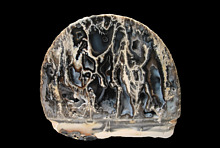Home PageAbout MindatThe Mindat ManualHistory of MindatCopyright StatusWho We AreContact UsAdvertise on Mindat
Donate to MindatCorporate SponsorshipSponsor a PageSponsored PagesMindat AdvertisersAdvertise on Mindat
Learning CenterWhat is a mineral?The most common minerals on earthInformation for EducatorsMindat ArticlesThe ElementsThe Rock H. Currier Digital LibraryGeologic Time
Minerals by PropertiesMinerals by ChemistryAdvanced Locality SearchRandom MineralRandom LocalitySearch by minIDLocalities Near MeSearch ArticlesSearch GlossaryMore Search Options
The Mindat ManualAdd a New PhotoRate PhotosLocality Edit ReportCoordinate Completion ReportAdd Glossary Item
Mining CompaniesStatisticsUsersMineral MuseumsClubs & OrganizationsMineral Shows & EventsThe Mindat DirectoryDevice SettingsThe Mineral Quiz
Photo SearchPhoto GalleriesSearch by ColorNew Photos TodayNew Photos YesterdayMembers' Photo GalleriesPast Photo of the Day GalleryPhotography
╳Discussions
💬 Home🔎 Search📅 LatestGroups
EducationOpen discussion area.Fakes & FraudsOpen discussion area.Field CollectingOpen discussion area.FossilsOpen discussion area.Gems and GemologyOpen discussion area.GeneralOpen discussion area.How to ContributeOpen discussion area.Identity HelpOpen discussion area.Improving Mindat.orgOpen discussion area.LocalitiesOpen discussion area.Lost and Stolen SpecimensOpen discussion area.MarketplaceOpen discussion area.MeteoritesOpen discussion area.Mindat ProductsOpen discussion area.Mineral ExchangesOpen discussion area.Mineral PhotographyOpen discussion area.Mineral ShowsOpen discussion area.Mineralogical ClassificationOpen discussion area.Mineralogy CourseOpen discussion area.MineralsOpen discussion area.Minerals and MuseumsOpen discussion area.PhotosOpen discussion area.Techniques for CollectorsOpen discussion area.The Rock H. Currier Digital LibraryOpen discussion area.UV MineralsOpen discussion area.Recent Images in Discussions
Techniques for CollectorsFluorine and Aluminum

18th Jul 2012 17:28 UTCSophiaJoy MB
1. If I put White Topaz and Almandine Garnet in water, do Fluorine in white topaz and Aluminum in garnet dissolve in water?
2. Fluorine is toxic, isn't it? Does it mean I should not keep touching topaz for a long time?? I don't know how fluorine in a mineral affects us...
Thanks for your help!

18th Jul 2012 17:57 UTCAlfredo Petrov Manager
Minerals (or any chemical compounds) do not have the properties of their individual elements. A good example of this is common salt, which is present in lots of our food. Its formula is NaCl, composed of the elements sodium (Na) and chlorine (Cl). Sodium is a dangerous metal, which bursts into flame if it comes into contact with water; and chlorine is a highly toxic gas used in chemical weapons. The sea salt on your table has none of those properties, because it is combined as a stable compound, just like the fluorine in your topaz.
18th Jul 2012 17:59 UTCReiner Mielke Expert
18th Jul 2012 18:56 UTCDean Allum Expert
There actually is a health effect to low-level fluorine concentrations: stronger bones and teeth.
100 years ago, a local dentist, here in Colorado, noticed that children who were born here tended to have few dental cavities. Scientific investigations suggested that it was due to the natural fluoride in the water (several ppM). Large scale water-fluoridation tests in Grand Rapids, Michigan showed the effectiveness of fluoride against dental cavities.
You can read the story here:
http://www.nidcr.nih.gov/oralhealth/topics/fluoride/thestoryoffluoridation.htm
By the way, a chemical reaction similar to what you described created a cryolite mineral deposit nearby, but the reaction happened at very high temperature.
Regards,
Dean Allum

18th Jul 2012 20:21 UTCSophiaJoy MB
Thank you very much!!




Mindat.org is an outreach project of the Hudson Institute of Mineralogy, a 501(c)(3) not-for-profit organization.
Copyright © mindat.org and the Hudson Institute of Mineralogy 1993-2024, except where stated. Most political location boundaries are © OpenStreetMap contributors. Mindat.org relies on the contributions of thousands of members and supporters. Founded in 2000 by Jolyon Ralph.
Privacy Policy - Terms & Conditions - Contact Us / DMCA issues - Report a bug/vulnerability Current server date and time: April 25, 2024 06:22:10
Copyright © mindat.org and the Hudson Institute of Mineralogy 1993-2024, except where stated. Most political location boundaries are © OpenStreetMap contributors. Mindat.org relies on the contributions of thousands of members and supporters. Founded in 2000 by Jolyon Ralph.
Privacy Policy - Terms & Conditions - Contact Us / DMCA issues - Report a bug/vulnerability Current server date and time: April 25, 2024 06:22:10










